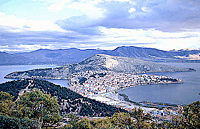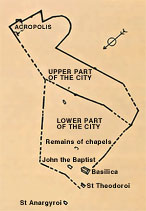 |
|
 |
Types of cities
 ccording to modern research there were three different types of cities.
ccording to modern research there were three different types of cities.
 There were fortified town or citadels, the character and function of which was purely defensive and military, cities that operated as commercial centres, while there was a third type of city we might call multifunctional. There were fortified town or citadels, the character and function of which was purely defensive and military, cities that operated as commercial centres, while there was a third type of city we might call multifunctional.
The fortified cities were surrounded by walls, were defended by a garrison and were usually governed by some nobleman. Their economy was chiefly based on agriculture, as a consequence of which they possessed no commercial class. These fortress-towns often constituted a pole of attraction for the rural population, since they were considered safe places in times of danger, such as during civil wars or enemy invasions. Among the best-known fortified cities were Kastoria, Edessa, Serres, Meleniko, Servia and Berroia.
There were also cities, however, that were purely commercial. A typical example
is that of Monemvasia, which, having been granted important commercial
and  administrative privileges in the
15th century, was able not only to develop its commercial
activities, but also to achieve a certain economic independence. Commercial transactions were more intensive in the coastal cities, a
fact attested by the example of such cities as Constantinople
and Thessalonike. The existence of large storage areas in the houses indicates that the commercial activities of their inhabitants must have been quite
important. It is worth noting that social
unrest was greatest in cities where commercial activity was most intense, since
it was there that the differences of wealth between the ruling class and the common people was most obvious. The urban layout of these cities afforded considerable possibilities
for defence, but there were also a number of quite luxurious
houses.
administrative privileges in the
15th century, was able not only to develop its commercial
activities, but also to achieve a certain economic independence. Commercial transactions were more intensive in the coastal cities, a
fact attested by the example of such cities as Constantinople
and Thessalonike. The existence of large storage areas in the houses indicates that the commercial activities of their inhabitants must have been quite
important. It is worth noting that social
unrest was greatest in cities where commercial activity was most intense, since
it was there that the differences of wealth between the ruling class and the common people was most obvious. The urban layout of these cities afforded considerable possibilities
for defence, but there were also a number of quite luxurious
houses.
Finally, a certain number of cities, such as
Ioannina, were at once military, administrative and commercial centres.
Nevertheless, it would have been difficult to distinguish the merchants
from the landowners. Although it was a fortified city and a very active
one economically, Ioannina retained its close ties to the land and to
agricultural production, since its commercial activities were mostly
centred around the agricultural produce of the region.
|